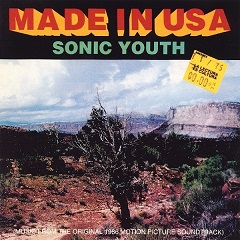
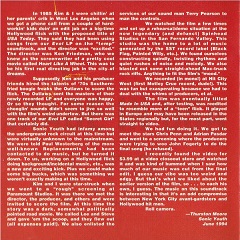
In Canada we had a fantastic TV channel called MuchMusic that was essentially our version of MTV through the 80s and 90s. One of their coolest daily features was a half-hour program called Spotlight that focused on one band, showing four or five videos and a few interview clips, typically from the MuchMusic HQ in Toronto or a nearby gig. You'd check the TV listings ahead of time to see which bands were coming up that week and try to tape the best ones. Back then, there was no YouTube or even readily accessible internet for most, let alone any streaming video. If you wanted to see music videos, you had to watch a channel like MuchMusic or hope the band released a home video compilation on VHS. Sometimes Spotlight would feature the same band a few months apart, but they'd swap out a video or use a different interview snippet. They'd also include updated bullet points of critical info on the band, offering details like line-up, current tour dates, recent releases, etc.
In early 1995 I was watching an episode on Sonic Youth. I'd seen a few before, and at this point I'd expect to see "Superstar", "Bull in the Heather", maybe "Dirty Boots" or "Kool Thing", and possibly something from Daydream Nation, "Beauty Lies in the Eye" or "Death Valley '69". They regularly used interview footage from 1988 and 1991 when the band played Toronto. However, this early '95 episode surprised me when it listed their most recent release as a soundtrack titled Made in USA. What?? I stormed the record stores as soon as I could. I think I found it at HMV, for $25 or so - a little more than a typical CD at the time. As a poor penniless preteen, I'd been practically begging my mom for a guitar tuner, but in this moment of weakness when forced to choose between a tuner and this mysterious new Sonic Youth disc, proper intonation never had a chance. It led to years of miserably awkward band practices and gigs, but when I consider how essential Made in USA was to my Sonic Youth experience, I don't regret any of the dead air or angry stares.
As I've detailed before, I spent the second half of 1994 acquiring the band's catalog in reverse. So, in early '95 I was craving anything new I could get my hands on, having branched out to singles and compilations. Gleefully bounding into the passenger seat, I scoured the packaging for any clues to its contents. The cover clearly identified it as "MUSIC FROM THE ORIGINAL 1986 MOTION PICTURE SOUNDTRACK", and the back specified "All music written, performed and produced by Sonic Youth". The wealth of tracks and their relative short lengths had me a little suspicious, and aside from "Secret Girl" I didn't recognize any of the frankly bizarre titles. My confusion peaked when I saw track 21: "O.J.'s Glove or What?". What?! The OJ Simpson murder trial had started and the glove was a well-worn joke at that point. But how could that have been the title of a 1986 song?
Oh, my 12-year-old brain. Later I'd discover that the songs were titled by Byron Coley during the production of the 1995 release, but at the time it seemed inexplicable. Ditching the shrink wrap I discovered very helpful liner notes from Thurston, penned in June 1994. He explained that the team making a film tentatively titled USA Today were using EVOL's "Secret Girl" on the temp soundtrack, and the band drafted to finish the score had bowed out. Sonic Youth were then given the opportunity to record unique music for the film, so they all went to Los Angeles in September 1986, between two legs of the American EVOL tours.


They started at Spinhead Studios, spending two weeks testing ideas and recording long sprawling instrumental jams while the film played on a TV. Some of this material circulated via tape trading in the 90s (sourced from the band themselves), but it wasn't until 2016's Spinhead Sessions that the recordings were officially released. After coming up with some tighter concepts, they went to Hit City West and started recording properly. Some of this material ended up in the film itself, but it remained more or less unreleased until the 1995 soundtrack.
Made in USA has been one of my favorite Sonic Youth releases since the day I came home from the mall and put the CD on at full volume in the living room. That fuzzy, car stereo version of the big rock theme that opens the disc was captivating, with its driving bass and glorious chord changes. All under a minute! When the next track was a super bright, fully produced half-speed version of the same theme, I was already won over. After the EVOL version of "Secret Girl" came two more fun little speed runs through the previous theme. Track 6 was the pay off: a complete vocal version of the developing progression, sung by Thurston and called "Tuck N Dar". While this may seem like another goofy throwaway title, it actually dates back to the film itself: the two main characters are named Tuck and Dar.
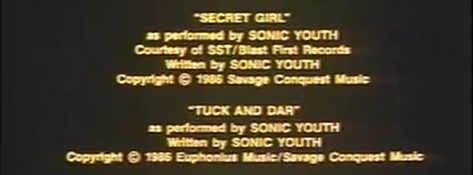
Full of upbeat energy, "Tuck N Dar" felt like a classic Sonic Youth track (and surely a future Song of the Week contender). Like the entire soundtrack, the enhanced production value really gives the material an almost majestic, magical sound, and it's fun to imagine a bizarro version of EVOL or Sister recorded in this higher quality environment. The rest of the soundtrack features more unique pieces, like the surf romp "Rim Thrusters", acoustic Fahey nod "Pocketful of Sen-Sen", something called "Thought Bubbles" that could almost be a Kim riff accented by backwards Lee speech...and of course, multiple takes on a harmonic/slide guitar motif that I will refer to wholly as "Made in USA".
In February 1994, a book compiling the first four issues of Bananafish was released, accompanied by a CD of music by artists who'd been featured in those issues. In addition to a live Lee Ranaldo scripture, there was a curious Sonic Youth track called "Made in USA segment". I first heard it long after Made in USA had been released, so I recognized it as the same theme featured in "Moon in the Bathroom" "Lincoln's Gout" "Coughing up Tweed" and "Smoke Blisters 3 & 4". It was a small sneak preview at music that was otherwise unavailable, unless you knew enough to track down a VHS copy of Made in USA. The full Sonic Youth soundtrack was released on Rhino a year later, in February 1995.
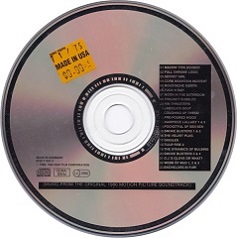
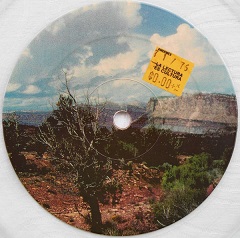
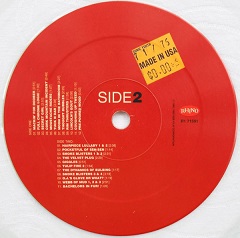
In summer 2004, the band released the first of a series of web-only streaming Mix Tapes, featuring unreleased material alongside current releases. The premiere volume included a strange 16-minute instrumental called "Spinhead" - the suggestion that it was from the Made in USA sessions perplexed me, at least until the track's seemingly endless manic tremolo strum section died down, giving way to a sweet, tentative instrumental reminiscent of some of the soundtrack material. Around the same time, an mp3 called "Made in USA Theme (Outtake)" was made available to download from sonicyouth.com, and it was clearly a loose, early version of the "Made in USA" theme, with an extended noise outro. Right on! Jump ahead 10 years or so, and 2016 brought the surprising release of Spinhead Sessions, a 7-track collection of material recorded at Spinhead Studios before recording the proper soundtrack. Both "Spinhead" and "Made in USA Theme" were included, now retitled "Ambient Guitar & Dreamy Theme" and "Theme With Noise".
The five previously unheard tracks were "High Mesa" "Unknown Theme" "Wolf" "Scalping" and "Theme 1 (Take 4)". I'll go ahead and say it now, "Theme With Noise", "Unknown Theme" and "Theme 1 (Take 4)" are essentially all versions of the "Made in USA" theme, with slight adjustments. I'd group anything based around that harmonic/slide pairing (which even pops up briefly in the more exploratory, improvised "High Mesa"). "Wolf" is a series of high chords strummed quickly, probably the least familiar sounding piece, and "Scalping" falls back into a similar ambient mood as the "Themes".
The aforementioned "bootleg" tapes containing the Spinhead material (never actually bootlegged in any fashion, suggesting a tighter circle of distribution) include some alternate mixes of "Ambient Guitar & Dreamy Theme" and "High Mesa", as well as a short portion of them seemingly writing "Hairpiece Lullaby" (which may have come out of the improvised "Dreamy Theme" ending to the "Ambient Guitar" track). There's also a few minute-long snippets of score, deceptively unexciting compared to the longer jams. The alternate mix of "Ambient Guitar" emphasizes a track of Lee's guitar that is not included on the official release. With this, as well as "Theme With Noise" and "High Mesa", I was able to come up with a tuning for Lee that I'm quite confident in: EEBBF#F#
Lee is in the left speaker on Spinhead Sessions. I am almost certain he is using the tuning EEBBF#F#, most likely with the Kimberly hollowbody guitar. It has a particular feedback sound that he utilizes throughout the soundtrack, along with its Bigsby bar. At the time, he was using this guitar for "Shadow of a Doubt" in F#F#AAEE - note that the Spinhead tuning lowers the bottom strings a step, while raising the A and the E up one. EEBBF#F# is actually a tuning Kim would use much later on "Sympathy for the Strawberry", and also quite close to Lee's EEBBEF# which popped up a few years later on Goo.
The "Shadow of a Doubt" connection is appropriate since Thurston's harmonic riff in the "Made in USA" theme seems to borrow heavily from that song, almost down to the picking pattern. Indeed, I figured his tuning was probably quite close to "Shadow", and the extensive open strings plucked out during "High Mesa" in particular have me equally as confident that I've cracked his tuning: EEF#GEB
Now, that's the F#F#F#F#EB tuning with the bottom F#s lowered to E, and the highest F# raised to G. I don't know for sure that this is the right order of notes, the high E could be lower than the F# and G, but it seems natural to me that it was based off the "Shadow" tuning. You can hear on "Theme With Noise" in particular how his harmonic riff has the semi-tone dissonance offered by the F#/G pairing, and the riffs are rooted in the harmonics on the low E strings. While I believe this to be the correct tuning for "Theme With Noise" "High Mesa" and "Unknown Theme" (still not 100% sure where "Ambient Guitar" lands), by "Theme 1 (Take 4)" I think he has made a slight alteration which removes some of the "spook" from the riff and keeps it a little prettier, simply by tuning the G down to F#: EEF#F#EB
I think he continued to use EEF#F#EB for the soundtrack itself, including "Moon in the Bathroom" "Coughing Up Tweed" and all the rest. I suspect he may have had at least one other tuning for the sessions (likewise Lee), but that's not my concern at the moment. What's concerning is that most of the Spinhead material, barring "Theme 1", seems to be tuned a half step below what I've listed (so, D#D#FF#D#A# and D#D#A#A#FF). That's no big deal, and tracked with something I'd found when I first tabbed the Bananafish version of "Made in USA" for this site - it was a half step down too. I figured that could have been a tape dub speed error, but hearing Spinhead Sessions confirmed that they seemed to be working in D# for a while. And that meant the Bananafish track was sourced from the rehearsals, not the proper album sessions (as is debated in the liners for Rarities 3).
The original Bananafish "Made in USA" theme does not have the dissonant notes from the early Spinhead material, and seems to be in EEF#F#EB (a half step down). It may have been the final version of the song before they moved to Hit City. I was surprised that none of the "Tuck N Dar" riffage appears to have been cooked up at Spinhead, though perhaps they left some stuff on the cutting room floor (if so, I plea for the release of the complete unedited Spinhead Sessions!!).
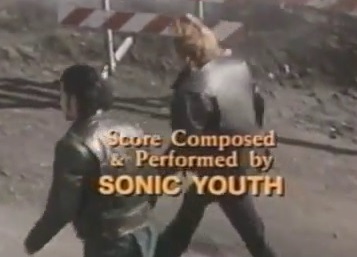
Here's where things get weird. While researching this article, I realized that the Bananafish "Made in USA" track does appear on the proper Made in USA soundtrack. It is actually the foundation of "Lincoln's Gout", and has been layered with swirling feedback. Most confusingly, it has been pitched to E. All of the Made in USA soundtrack seems to be in E, but the Spinhead material was definitely D#, as was the original release of "Made in USA". Maybe they recorded the initial track at Spinhead, brought it to Hit City to further overdub, and changed the pitch then? Well, that may be exactly what happened...
It seems there's a basic track featuring two of Thurston's guitars playing harmonics, Lee playing a gliding slide riff, light percussive accents from Steve, and Kim playing a simple bass riff that changes from a repeated E harmonic to a G and E progression that is reminiscent of the outro to "The Diamond Sea" (curiously, the band would have been just finishing up this soundtrack for its release in 1995 when they wrote "The Diamond Sea"...). This is effectively what the Bananafish version is, in D#. "Lincoln's Gout" uses the same track, now pitched to E, with Lee recording two new slide guitar parts, and a wall of swirling feedback in the background. "Smoke Blisters 3 & 4" uses the same basic track, also in E, with varying elements added or removed: part 3 includes both the feedback swirl as well as some behind-the-bridge jingle, while part 4 doesn't feature Lee and Steve at all, and only includes one of Thurston's guitar parts (the bridge jingle is present, the feedback swirl is not).
I mentioned a few short score tracks on the "bootleg" tapes of the Spinhead sessions. At first they seemed innocuous, obviously evocative of the other material but not particularly noteworthy. One features a spoken intro by Lee that I can't explain at all: "This is the high desert. 8M3 wed to 8M4. A timed pause, and 8M5." He may be saying "AM3" and not "8M3" (and possibly "wet" instead of "wed"?). The track proceeds to be a jumbled mess of behind the bridge jangle, atonal harmonic strums blended with perfectly tonal harmonic strums, general neck tapping overtones, and...swirling feedback. In fact, it ends with undeniably the same swirl that completes "Lincoln's Gout". So, digging deeper, it became apparent that this track was the source for the feedback in the "Lincoln's Gout" and "Smoke Blisters 3" versions of the "Made in USA" theme. The third snippet on the bootleg tape is another run through that same theme, featuring just Thurston's guitar and Kim's bass with excessive behind-the-bridge jangle. It fades early, and seems fleeting enough, until I realized that it is actually "Smoke Blisters 4". Which means it is the same basic track as "Made in USA", "Lincoln's Gout", and "Smoke Blisters 3". So the feedback swirl and the original track seem to date to Spinhead, and both are in D# on the bootleg tape (as is the first piece, a minute of layered harmonic/slide guitar work).

"Moon in the Bathroom" and "Coughing Up Tweed" appear to be unique takes on the same theme, and they share two key differences from the original "Made in USA" version. Thurston's riff basically cycles from 5th fret to 7th fret to 12th fret harmonics, whether strummed or arpeggiated. When he gets to the arpeggiated 7th fret harmonic in the original version (heard also in "Theme With Noise"), he ends the bar by playing the open B string a few times. It actually bugs the hell out of me, because it really sounds like he has unison B strings with one slightly out of tune. But I'm pretty sure the tuning is EEF#F#EB and he's either fretting the other B or it's just a weird echo from how the string sits, or something.... In "Moon" and "Tweed" (as well as "Unknown Theme" and "Theme 1"), he does harmonics straight through and does not hit the open string.
The other difference is that the theme no longer has an "A" and "B" section. While "Made in USA" began with a building harmonic chord rhythm which led to an arpeggiated harmonic riff accompanied by a slide guitar part, "Moon" and "Tweed" are just the arpeggio/slide portion. The harmonic picking pattern was refined along the way. If you go back to "Theme With Noise", he is playing the root notes on the low E strings, very much like "Shadow of a Doubt". By the time they recorded the "Made in USA" version, and future takes like "Coughing Up Tweed", he'd removed the low strings from the riff, picking out just the key notes on the F#F#EB strings. However, the first part of the song, where he strums low harmonic chords, seem to confirm the low Es in the tuning are still there. Though this section is removed from "Moon" and "Tweed", I assume he is still in EEF#F#EB.
As far as Lee goes, it sounds like he recorded multiple slide guitar parts for each version. He basically does light open string tapping or harmonics with heavy reverb and tremolo for the "A" section, then plays a variation of the same slide guitar melody. I've tabbed it up at the 17th fret, but you can also play it at the 12th fret. You can also play the riff with exaggerated bends instead of a slide, if that's your preference.
I obviously can't be 100% sure about Lee using the Kimberly hollowbody, but it sounds plausible based off his various tones. I also wonder if Thurston was using the blue Jazzmaster, known for its behind-the-bridge brightness. These were the two instruments they used when performing a live soundtrack for a Mike Kelley play just three months later, which could be telling. I can't imagine they dragged their entire arsenal across the country to record this soundtrack, especially when so much of it sounds so similar. I suspect there's another tuning heard on "Scalping" (but I can't quite wrap my head around what I'm hearing) and stuff like "Hairpiece Lullaby" can't be played in EEF#F#EB. So they may have brought a couple each, and I'd bet the Kimberly and blue Jazz were among them.
So that's "Made in USA". The song, at least. We'll talk about more of the soundtrack later - "Secret Girl" and "Tuck n Dar" and "Rim Thrusters" and all the rest. Maybe we should talk about the movie itself, though. I found a copy to rent on VHS and posted a review to the alt.music.sonic-youth group on April 12th, 2000 after a single viewing. I basically identified all timepoints where Sonic Youth music could be heard, which was more often than I was expecting. A lot of the score appears in the same order as the eventual 1995 soundtrack, including the climactic one-two punch of "Webb of Mud" into "Bachelors in Fur!". The credits identify only two tracks by name, "Secret Girl" and "Tuck and Dar" (not "N" like the soundtrack). I hoped this meant both tracks appeared on the original 1987 motion picture soundtrack (imagine a contemporary release of "Tuck and Dar" hiding out there!) but sadly that compilation features "Secret Girl" stranded alone in a sea of 80s schlock.
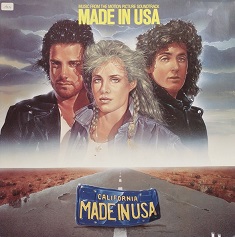
I watched the film for the second time in 23 years, adjusting my previous findings slightly. It's cool to hear this music I love so much pop up during the movie, but also shocking to hear how much non-descript blues rock boogie bullshit drives the scenes that could otherwise benefit from a more subdued score (or, when in doubt, "Rim Thrusters"!!). There's some great desolate scenery and enough of a story to keep you awake while waiting for the next iteration of "Secret Girl" to creep up, but I certainly wouldn't recommend it without its connection to the early Sonic lore.
That makes just shy of 17 minutes of Sonic Youth music in the film.
There's also a trailer for the film out there, which starts with "Secret Girl" before heavily leaning into the glory of "Rim Thrusters" to sell the potential viewer that this would be a fun way to spend 82 minutes. One thing to keep in mind is that the 1995 soundtrack was all mixed in June 1994 at Sear Sound. So, anything heard in the film would theoretically be an alternate, original mix from '86 or '87. Sure, most of their music has dialog over it, but it's still cool to think that had Made in USA not been released as its own soundtrack, there would be these extremely mysterious, untitled score pieces immortalized on the soundtrack of an obscure cut-out flick.
The band was interviewed by Mark Dery for the August 1987 issue of RIP magazine. While "Made in USA" is mentioned on the cover, the band discusses various cult and underground films, their Mojave Desert performance, and the recording sessions for Sister. They touch on Made in USA, with Lee saying the following: "It's directed by a guy named Ken Friedman, who wrote Heart Like a Wheel. It's his first directorial attempt, and it's got Chris Penn in it, Sean's little brother, and this woman named Lori Singer, and a hot young guy named Adrian Pazdar. They had contracted this horrible band to do the soundtrack for it, whose music they ultimately rejected once it was handed in. So, then they were just groping around, putting stuff of recordings on the rough-edit soundtrack. They liked a couple of things by us, and ultimately called us up out of the blue and said, 'Maybe you guys would be willing to do the soundtrack; your music is kind of right.' They somehow imagined that we would be able to do the right thing for their movie. It's a road movie about two guys who are sort of losers and are traveling across the country. It has a lot of landscape imagery, and there's one whole section that takes place in the desert. It also has a sort of message about pollution and corporate criminals playing with tanks. We just rented a demo studio, put on the videotape, had a television in front of us, and just started playing. For about two weeks, we just did that."
Okay, so...here's a rough guide to summarize everything I explained above. This specifies Thurston's tuning and whether it's a half step down. It also says whether the A and B sections are played, or just the B section (the arpeggiated harmonics), and if the open B string is part of the 7th fret cycle. For the songs using the Bananafish "Made in USA" as a basic track, I've listed which changes were made. While they may have considered these changes to be sufficient enough to call them different themes, I feel like Lee's slide guitar melody is so specific that it's fair to consider these all related.
| VERSION | RELEASE | TUNING | NOTES |
| THEME WITH NOISE | Spinhead Sessions | EEF#GEB (1/2 step down) | Just the arpeggiated harmonics, with open B string. |
| UNKNOWN THEME | Spinhead Sessions | EEF#GEB (1/2 step down) | Both sections. No open B string in arpeggiated riff. |
| THEME 1 (TAKE 4) | Spinhead Sessions | EEF#F#EB | Both sections, kind of. No open B string in arpeggiated riff. |
| MADE IN USA | Bananafish compilation | EEF#F#EB (1/2 step down) | Both sections, with open B string in arpeggiated riff. |
| LINCOLN'S GOUT | Made in USA | EEF#F#EB | Uses same basic track as "Made in USA" (in E) merged with track of feedback from Spinhead rehearsals. Features two tracks of Lee guitar. |
| SMOKE BLISTERS 3 | Made in USA | EEF#F#EB | Uses same basic track as "Made in USA" (in E) merged with track of feedback from Spinhead rehearsals. Features only part of Thurston's harmonic guitar, and a different Lee part. Also features behind-the-bridge jingle. |
| SMOKE BLISTERS 4 | Made in USA | EEF#F#EB | Uses same basic track as "Made in USA" (in E) with some behind-the-bridge jingle. Only one of Thurston's guitars is in this mix, and Lee and Steve do not appear. |
| MOON IN THE BATHROOM | Made in USA | EEF#F#EB | Just the arpeggiated harmonics, no open B string. |
| COUGHING UP TWEED | Made in USA | EEF#F#EB | Just the arpeggiated harmonics, no open B string. |
Did I really need to tab all of these different versions of what is basically a simple harmonic and slide guitar progression? Probably not, but it did help me unlock some of the hidden layers of these various takes that turned out to not be so different after all. While they appear mostly chronologically, I think "Made in USA" should technically appear between "Unknown Theme" and "Theme 1 (Take 4)", considering the key matches "Unknown" but the tuning matches "Theme 1". Regardless, I put "Made in USA" at the top since it is the purest version of the song and its very basic riffs, and also the first version released officially. I suppose I should have also included "High Mesa" since the theme does get referenced there, but I might climb that hill in the future. I hope you enjoyed this possibly too-deep dive into the theme from Sonic Youth's first soundtrack. Please let me know what you think! As always, comments and corrections are appreciated.
One last note - I was very sad to hear that Catherine Ceresole passed earlier this month. Her photographs were such an essential element to my "Early Sonic" piece as well as just being legendary documents of a very important scene. I wish I'd reached out to her to let her know how much I appreciated her role in the band's history, and to thank her for being there and taking notes. R.I.P.

"MADE IN USA"
[from the 1994 STEP, STEP, STEPPIN' ON SATAN'S FOOT compilation + RARITIES 3]
NOTE: All instruments sound 1/2 step down from above tunings.
LAYOUT
A - B
KIM
EADG
CENTER
THURSTON
EEF#F#EB
CENTER
LEE
EEBBF#F#
CENTER
A SECTION 00:00-01:09
Thurston recorded two parts, one with the low harmonic rhythm and one with the slow
raking harmonic strums that happen each time he changes frets.
His part fades in at the 7th fret, but the cycle technically goes 5th to 7th to 12th.
On each repeat, he will sometimes throw in the harmonics on the F# strings as well.
I haven't specified each time he plays the bracketed notes, as they are random.
B---------------------------------------------------------------------
E---------------------------------------------------------------------
F#-----------------(*5*)-----------------------(*5*)---(*5*)----------
F#-----------------(*5*)-----------------------(*5*)---(*5*)----------
E---*5*-*5*-*5*-*5*-*5*-*5*-*5*-*5*-*5*-*5*-*5*-*5*-*5*-*5*-*5*-*5*---
E---*5*-*5*-*5*-*5*-*5*-*5*-*5*-*5*-*5*-*5*-*5*-*5*-*5*-*5*-*5*-*5*---
B---------------------------------------------------------------------
E---------------------------------------------------------------------
F#---------(*7*)-----------------------(*7*)--------------------------
F#---------(*7*)-----------------------(*7*)--------------------------
E---*7*-*7*-*7*-*7*-*7*-*7*-*7*-*7*-*7*-*7*-*7*-*7*-*7*-*7*-*7*-*7*---
E---*7*-*7*-*7*-*7*-*7*-*7*-*7*-*7*-*7*-*7*-*7*-*7*-*7*-*7*-*7*-*7*---
B------------------------------------------------------------------------------------
E------------------------------------------------------------------------------------
F#-----------(*12*)----(*12*)-----------------------------(*12*)---------------------
F#-----------(*12*)----(*12*)-----------------------------(*12*)---------------------
E---*12*-*12*-*12*-*12*-*12*-*12*-*12*-*12*-*12*-*12*-*12*-*12*-*12*-*12*-*12*-*12*--
E---*12*-*12*-*12*-*12*-*12*-*12*-*12*-*12*-*12*-*12*-*12*-*12*-*12*-*12*-*12*-*12*--
Play the full progression 5 times.
The harmonic chords strummed at the start of each part match the low E harmonic:
B----*5*--------*7*---------*12*-------
E----*5*--------*7*---------*12*-------
F#---*5*--------*7*---------*12*------- x 5
F#---*5*--------*7*---------*12*-------
E----*5*--------*7*---------*12*-------
E----*5*--------*7*---------*12*-------
Lee's part is mostly open strings with heavy reverb and tremolo. The song begins with him
tapping the neck to chime out the open strings, which he continues softly striking each
time Thurston changes frets. At 0:24 he loudly plays the open F# strings. He's mostly making
ambient backing to Thurston's riff before preparing to come in with his slide riff.
Kim is mostly playing an E harmonic, possibly letting the low E in at times.
G-----------------------------------------
D-----------------------------------------
A---*7*-*7*-*7*-*7*-*7*-*7*-*7*-*7*-*7*--- etc
E-----------------------------------------
B SECTION 01:09-01:56
Thurston plays an arpeggiated harmonic riff. You can play the root harmonic on the low E strings,
but it sounds like he just picks out the center notes in the "final" version of the song. Each
repetition is slightly varied.
B---------------------------------*5*--
E-------------*5*------------*5*-------
F#--------*5*----*5*------*5*---*5*----
F#-----*5*-------------*5*-------------
E--------------------------------------
E--------------------------------------
B------------------------0-0-0-0-0-0---
E--------------*7*------(7)------------
F#--------*7*------*7*-----------------
F#-----*7*-----------------------------
E--------------------------------------
E--------------------------------------
B-----------------------------------------*12*-----
E---------------*12*--------------*12*-------*12*--
F#---------*12*-----*12*------*12*----*12*---------
F#-----*12*----------------------------------------
E--------------------------------------------------
E--------------------------------------------------
Play entire progression 4 times, fade out on 7th fret.
Lee:
F#-------------------------------------------------------------
F#-------------------------------------------------------------
B--------------------------------------------------19\\\17-----
B------------19----19\20/19--17--------------19----19\\\17-----
E---17\\\19-------------------------17\\\19--------------------
E--------------------------------------------------------------
F#---------------------------------\17~----17~----17~----17~---
F#---------------------------------\17~----17~----17~----17~---
B------------------------------------------17~----17~----17~---
B------------19----19\20/19--17--------------------------------
E---17\\\19----------------------------------------------------
E--------------------------------------------------------------
He may be playing the first part at the 10th-12th fret and sliding up to the 17th for the second part.
If you don't have a slide, you can mimic it with heavy bends:
F#-------------------------
F#-------12~~---12br-10~~~-
B----10b-------------------
B--------------------------
E--------------------------
E--------------------------
Kim plays:
G-----------------------------------------------
D-----------------------------------------------
A---10-10-10-10-10-10-10-10---7-7-7-7-7-7-7-7--- repeat simile X 9 (fade)
E---------------------------0-------------------
text + tab by Chris Lawrence
"THEME WITH NOISE"
[from SONICYOUTH.COM FREEBIES + SPINHEAD SESSIONS]
NOTE: All instruments sound 1/2 step down from above tunings.
LAYOUT
A - B
KIM
EADG
CENTER
THURSTON
EEF#GEB
RIGHT
LEE
EEBBF#F#
LEFT
A SECTION 00:00-02:46
Thurston repeats a variation on a simple 5th to 7th to 12th fret harmonic riff. In this version,
he emphasizes the semi-tone present in this tuning. Each repetition is played slightly differently,
and sometimes he slips in open strings when he misses the harmonic. He doesn't always end the 7th fret
run with the open string, but often enough.
B-------------------------------------------------*5*------
E----------------------------------------------------*5*---
G-----------*5*-------*5*----------------------*5*---------
F#-----------------*5*----------------------*5*------------
E---*5*-*5*----*5*---------*5*-*5*-*5*-*5*-----------------
E---*5*-*5*----*5*---------*5*-*5*-*5*-*5*-----------------
B-------------------------------------------0-0-0--0-0---
E-------------------------------------------7-7-7--7-7---
G-----------*7*-------*7*----------*7*-------------------
F#-----------------*7*-------------*7*-------------------
E---*7*-*7*----*7*---------*7*-*7*-----------------------
E---*7*-*7*----*7*---------*7*-*7*-----------------------
B----------------------------------------*12*------
E---------------------*12*-------------------*12*--
G-----------------*12*----*12*---------------------
F#------------*12*--------------------*12*---------
E---*12*-*12*-------------------*12*---------------
E---*12*-*12*-------------------*12*---------------
Play the full progression 10 times.
At 2:25 he starts hitting open strings as they wind down:
B--------------------------------------------*5*---0-*5*-----0-----
E------------------------------------------------------------------
G-----------------------------------------0------------------------
F#--------------------------------------0----------------------0---
E---0-------------0-------------0----------------------------------
E---0---0-0-0-0-0-0---0-0-0-0-0-0----------------------------------
Lee uses a bit of reverb and tremolo. He starts by playing the low E strings a few times, then
knocks all the open strings. At 0:25 he plays some harmonics:
F#--*12*------------
F#-------*12*------- then keep softly striking open strings
B-------------*12*--
B-------------------
E-------------------
E-------------------
At 0:45 he begins the slide theme:
F#--------------------------------------------------------------------------
F#--------------------------------------------------------------------------
B---------------------------------------------------------------------------
B-----------------19----19\20/19--17----------------19----19\20/19----------
E--------17\\\19---------------------------17\\\19------------------19/17---
E---0-----------------------------------------------------------------------
F#--------------------20~~-/19-19~~/17~~---17-17-17~~--17~--17~~--17~---------
F#----------------------------------------------------------------------------
B---------------------------------------------------------17~--------17~17~---
B------------19---------------------------------------------------------------
E---17\\\19-------------------------------------------------------------------
E-----------------------------------------------------------------------------
F#-------------17~-------17~-------17~-------17~-------17~-------17~~-------
F#--------------------------------------------------------------------------
B----17-17~17~----17~17~----17~17~----17~17~----17~17~----17~17~-------17---
B---------------------------------------------------------------------------
E---------------------------------------------------------------------------
E---------------------------------------------------------------------------
F#-----------------------------------------------------
F#-----------------------------------------------------
B------------------------------------------------------
B---17\\19---20/19--19~~-----------------19--19///17---
E---17\\19----------------19~----17\\19----------------
E------------------------------------------------------
F#-----------------------------------------------------
F#----------------------------------------------17~~~~-
B------------------------------------------------------ rub slide @ 17th fret on B+F# strings
B------------20/19---19///17~~------------19~~~~-------
E---17\\19-----------------------17\\19----------------
E------------------------------------------------------
At 2:03 he returns to open E notes:
F#-----------------*12*-----------*12*------------*12*---
F#-----------------*12*-----------*12*------------*12*--- let the F# notes ring out to feedback and hold
B------------------*12*-----------*12*-------------------
B--------------------------------------------------------
E--------------0--------------*12*------------0----------
E---0----------0--------------*12*------------0----------
Kim repeats this:
G---------------------------------------------
D---------------------------------------------
A---10-10-10-10-10-10-10-10-7-7-7-7-7-7-7-7--- (you can add the low E as well)
E---------------------------------------------
B SECTION 02:46-04:16
For the noise outro, based on the mix positions it sounds like Lee is rapidly picking the low E strings
the entire time, while Thurston and Kim make droning feedback. However, a lot of the feedback in these
sessions sounds like Lee's hollowbody Kimberly guitar, so I would expect him to be the one doing
that feedback. I don't think it's Kim's bass picking at the E note, and it's in Lee's channel,
so...maybe he did that in addition to a second track of feedback?
text + tab by Chris Lawrence
"UNKNOWN THEME"
[from SPINHEAD SESSIONS]
NOTE: All instruments sound 1/2 step down from above tunings.
LAYOUT
A - B - A - B
KIM
EADG
CENTER
THURSTON
EEF#GEB
RIGHT
LEE
EEBBF#F#
LEFT
A SECTION 00:00-00:38 Thurston repeats a variation on the simple 5th to 7th to 12th fret harmonic riff. B--------------------------------------------------------------------- E--------------------------------------------------------------------- G---*5*-----------------------------*5*------------------------------- F#--*5*-----------------------------*5*------------------------------- E---*5*-*5*-*5*-*5*-*5*-*5*-*5*-*5*-*5*-*5*-*5*-*5*-*5*-*5*-*5*-*5*--- E---*5*-*5*-*5*-*5*-*5*-*5*-*5*-*5*-*5*-*5*-*5*-*5*-*5*-*5*-*5*-*5*--- B--------------------------------------------------------------------- E--------------------------------------------------------------------- G---*7*-----------------------------*7*------------------------------- F#--*7*-----------------------------*7*------------------------------- E---*7*-*7*-*7*-*7*-*7*-*7*-*7*-*7*-*7*-*7*-*7*-*7*-*7*-*7*-*7*-*7*--- E---*7*-*7*-*7*-*7*-*7*-*7*-*7*-*7*-*7*-*7*-*7*-*7*-*7*-*7*-*7*-*7*--- B------------------------------------------------------------------------------------- E------------------------------------------------------------------------------------- G---*12*------------------------------------*12*-------------------------------------- F#--*12*------------------------------------*12*-------------------------------------- E---*12*-*12*-*12*-*12*-*12*-*12*-*12*-*12*-*12*-*12*-*12*-*12*-*12*-*12*-*12*-*12*--- E---*12*-*12*-*12*-*12*-*12*-*12*-*12*-*12*-*12*-*12*-*12*-*12*-*12*-*12*-*12*-*12*--- Play the full progression 3 times. Lee strikes the open F# strings and then immediately turns on the tremolo. He lightly taps the back of the neck and occasionally strikes the open F# and E strings. Kim repeats this: G----------------------------------------- D----------------------------------------- A---7-7-7-7-7-7-7-7-7-7-7-7-7-7-7-7-7-7--- etc (could also do harmonics) E----------------------------------------- B SECTION 00:38-01:37 Thurston plays a choppy version of the arpeggiated harmonic riff. It's not played exactly, with a bit of sloppiness and open strings. B------------------------------------------------- E------------------------------------------------- G---------*5*-------*5*---------*5*-----*5*-*5*--- F#--------*5*----*5*------------*5*-*5*-*5*-*5*--- E--*5*-*5*----*5*-------*5*-*5*-----*5*-*5*------- E--*5*-*5*----*5*-------*5*-*5*-----*5*----------- B--------------------------------------------------- E--------------------------------------------------- G---------*7*--------*7*--------------*7*----*7*---- F#---------------*7*---------------*7*----*7*------- E--*7*-*7*---*7*----------*7*-*7*------------------- E--*7*-*7*---*7*----------*7*-*7*------------------- B----------------------------------------------------*12*------- E----------------------*12*------------------------------------- G-----------------*12*------*12*----------------*12*-----*12*--- F#-----------*12*--------------------------*12*----------------- E--*12*-*12*---------------------*12*-*12*---------------------- E--*12*-*12*---------------------*12*-*12*---------------------- Play entire progression 4 times, then play just the 5th fret riff once. Lee: F#------------------------------------------------------------------------ F#------------------------------------------------------------------------ B------------------------------------------------------------------------- B------------19----19\20/19--17----------------19------------------17~~~-- E---17\\\19---------------------------17\\\19----------19//////17--------- E------------------------------------------------------------------------- F#--------------------20~~20~~20~/19~~~-20~~20~/19~~~---------------------------------- F#------------------------------------------------------------------------------------- B-------------------------------------------------------------------------------------- B--------------------------------------------------------------19~~---19//17-17-------- E---17\\\19~~~~~--------------------------------------17\\\19-------------------------- E----------------------------------------------------------------------------------0--- Kim: G--------------------------------------------- D--------------------------------------------- A---10-10-10-10-10-10-10-10-7-7-7-7-7-7-7-7--- repeat X 13 E--------------------------------------------- A SECTION 01:38-01:58 Thurston plays the entire harmonic chord progression 2 times. Lee plays the open F# strings with tremolo, and then the low E. At 1:52 you can hear the middle B strings more clearly than usual. Kim repeats this: G----------------------------------------- D----------------------------------------- A---7-7-7-7-7-7-7-7-7-7-7-7-7-7-7-7-7-7--- etc E----------------------------------------- B SECTION 01:58-02:41 Thurston plays the entire arpeggiated harmonic progression 3 times. Lee: F#------------------------------------------------------------------- F#------------------------------------------------------------------- B-------------------------------------------------------------------- B------------19----19\20/19--17----------------19-----19\20/19--17--- E---17\\\19---------------------------17\\\19------------------------ E-------------------------------------------------------------------- F#---------------------------------------------\17~~~-17~~~17~~~17~~~--- F#---------------------------------------------\17~~~-17~~~17~~~17~~~--- B----------------------------------------------------------------------- B------------19----19\20---------19-----19\20--------------------------- E---17\\\19--------------17\\\19---------------------------------------- E----------------------------------------------------------------------- Kim: G--------------------------------------------- D--------------------------------------------- A---10-10-10-10-10-10-10-10-7-7-7-7-7-7-7-7--- repeat X 8 E--------------------------------------------- End on G (10th fret). text + tab by Chris Lawrence
"THEME 1 TAKE 4"
[from SPINHEAD SESSIONS]
LAYOUT
A
KIM
EADG
CENTER
THURSTON
EEF#F#EB
RIGHT
LEE
EEBBF#F#
LEFT
A SECTION 00:00-02:32
Thurston starts by doing his 5th to 7th to 12th fret harmonic chord strumming, though it's a
little quieter than other takes and he picks out more notes than steady strumming.
At 0:49, Thurston starts playing the typical harmonic theme:
B--------------------------------------*5*--
E--------------*5*----------------*5*-------
F#--------*5*-----*5*--------*5*-----*5*----
F#-----*5*---*5*----------*5*---*5*---------
E--*5*--------------------------------------
E--*5*--------------------------------------
B-----------------------------------------------
E---------------*7*------------------*7*--------
F#--------*7*------*7*---------*7*------*7*-----
F#-----*7*---*7*------------*7*---*7*------*7*--
E--*7*------------------------------------------
E--*7*------------------------------------------
B---------------------------------------------*12*-----
E-------------------*12*--------------*12*-------*12*--
F#-----------*12*-------*12*------*12*----*12*---------
F#-------*12*----*12*----------------------------------
E--*12*------------------------------------------------
E--*12*------------------------------------------------
Play entire progression 5 times.
At 2:00, play just the 5th fret harmonic riff again, then:
B----2-2-2--0-0-----0---2----------2-0~~---2---------0-0~~---2-------0-0~~---
E-------------------------0-0-0--------------0-----------------0-------------
F#---------------------------------------------------------------------------
F#---------------------------------------------------------------------------
E----------------------------------------------------------------------------
E----------------------------------------------------------------------------
Lee starts by holding the slide at the 19th fret and striking chords, sometimes moving
them subtly with the slide.
F#---------
F#---------
B----19----
B----19---- pick notes out of this shape for a bit
E----19----
E----19----
At 0:44 hit the low E and move to a different note:
F#---------17-----17-----17---- ----12----
F#---------17-----17-----17---- etc / at 1:03 switch to: ----12---- etc
B-----------0------0------0---- -----0----
B------------------------------ ----------
E------------------------------ ----------
E----0------------------------- ----------
To the slide riff at 1:20
F#-------------------------------------
F#-------------------------------------
B-------------------------------------- play variation twice
B-----------19~~-----19//17-17~~-------
E---17\\\19----------------------------
E--------------------------------------
At 1:34 start strumming harmonics at the 12th fret (or the 19th fret on the low EB strings)
F#---*12*-*12*-*12*-*12*-*12*-*12*-*12*-*12*-*12*-*12*---
F#---*12*-*12*-*12*-*12*-*12*-*12*-*12*-*12*-*12*-*12*---
B----*12*-*12*-*12*-*12*-*12*-*12*-*12*-*12*-*12*-*12*--- etc etc
B----*12*-*12*-*12*-*12*-*12*-*12*-*12*-*12*-*12*-*12*---
E--------------------------------------------------------
E--------------------------------------------------------
Around 1:56 he hits the open F# strings a few times then goes back to the harmonic strumming
which continues til the end.
Kim repeats this:
G--------------------------------------------
D-------------------------------------------- x 18
A---7-7-7-7-7-7-7-7-10-10-10-10-10-10-10-----
E----------------------------------------0---
At 1:34 she switches to:
G-------------------11-11-11-11-11-11-11-----
D-------------------------------------------- x 11 (no low E on final repeat)
A---7-7-7-7-7-7-7-7--------------------------
E----------------------------------------0---
text + tab by Chris Lawrence
"MOON IN THE BATHROOM"
[from MADE IN USA]
LAYOUT
A
KIM
EADG
CENTER
THURSTON
EEF#F#EB
CENTER
LEE
EEBBF#F#
LEFT/RIGHT
A SECTION 00:00-02:29
This one has a lot of "overtones" overdubbed, backwards feedback etc.
Thurston comes in around 0:14 playing his familiar arpeggiated harmonic figure.
I think he may have stopped playing the root notes on the low E strings at the
start of each cycle, but you could still add them. I swear I hear them sometimes...
B-------------------------------------*5*--
E-------------*5*----------------*5*-------
F#-------*5*-----*5*--------*5*-----*5*----
F#----*5*---*5*----------*5*---*5*---------
E------------------------------------------
E------------------------------------------
B----------------------------------------------
E--------------*7*------------------*7*--------
F#-------*7*------*7*---------*7*------*7*-----
F#----*7*---*7*------------*7*---*7*------*7*--
E----------------------------------------------
E----------------------------------------------
B------------------------------------------*12*-----
E----------------*12*--------------*12*-------*12*--
F#--------*12*-------*12*------*12*----*12*---------
F#----*12*----*12*----------------------------------
E---------------------------------------------------
E---------------------------------------------------
He strays a bit on repetitions 4 and 5, just hitting loose harmonics out of rhythm.
Play the full progression 11 times the end on just the 5th fret harmonic riff.
Lee has two guitars, left and right, playing similar things but not in sync.
LEFT RIGHT RIGHT LEFT
F#-------------------------------------------------------
F#-------------------------------------------------------
B---17\\\19----------------------------------------------
B---17\\\19----------------------------------------------
E---17\\\19----------------------------------------------
E---17\\\19--------10\\\12--------14////-----10\\\12-----
At 0:25 the main slide theme is played by one guitar:
F#---------------------------------------------------------------------------------
F#---------------------------------------------------------------------------------
B-----------------------------------------------------19\\\17-17--------17~~/////--
B------------19----19\20/19--17--------------19-------19\\\17-17--------17~~/////--
E---17\\\19-------------------------17\\\19--------19-------------------17~~/////--
E-----------------------------------------------------------------------17~~/////--
At 0:49 he plays:
F#---------------------------------------------------------
F#---------------------------------------------------------
B----------------------------------------------------------
B---14\15--15/14--14~-------14\\15~~--------17\\\19--17~~--
E-----------------14~--------------------------------------
E----------------------------------------------------------
F#----------------------------------------
F#----------------------------------------
B-----------------------------------------
B---14\15--15/14-------------14\15/14~~---
E-----------------14~---------------------
E-----------------------------------------
At 1:26 he comes back with the slide motif:
F#--------------------------------------------------------------------------
F#--------------------------------------------------------------------------
B--------------------------------------------------------------19\\\17-17---
B----------------------19----19\20/19--17--------------19------19\\\17-17---
E-------------17\\\19-------------------------17\\\19-------19--------------
E---11\12~~~----------------------------------------------------------------
F#----------------------------------------------------------------
F#----------------------------------------------------------------
B-----------------------------------------------------------------
B------------19----19\20/19--17--------------19----19\20/19--17---
E---17\\\19-------------------------17\\\19-----------------------
E-----------------------------------------------------------------
F#---19\20-20/19------------19/20\19--19--19~---19----19-----19---------
F#---19\20-20/19------------19/20\19--19--19~---19----19-----19---19~~--
B----------------19------19------------------19----19-----19------19~~--
B----------------19------19------------------19----19-----19------19~~--
E-----------------------------------------------------------------------
E-----------------------------------------------------------------------
F#--15~/\/------15~/\/17~~~-----15~/\/17~~~--
F#--15~/\/------15~/\/17~~~-----15~/\/17~~~--
B---15~/\/------15~/\/17~~~-----15~/\/17~~~--
B---15~/\/------15~/\/17~~~-----15~/\/17~~~--
E-------------------------------15~/\/17~~~--
E-------------------------------15~/\/17~~~--
Kim starts with that harmonic-sounding E, then at 0:22 she starts the G to E motif til the end.
G-----------------------------------------
D-----------------------------------------
A---*7*-*7*-*7*-*7*-*7*-*7*-*7*-*7*-*7*--- etc
E-----------------------------------------
G-----------------------------------------------
D-----------------------------------------------
A---10-10-10-10-10-10-10-10---7-7-7-7-7-7-7-7--- x 32
E--------------------------(0)------------------
text + tab by Chris Lawrence
"LINCOLN'S GOUT"
[from MADE IN USA]
LAYOUT
A - B
KIM
EADG
CENTER
THURSTON
EEF#F#EB
CENTER
LEE
EEBBF#F#
LEFT/RIGHT
This whole song contains a track of swirling feedback underneath the basic "Made in USA" tune.
A SECTION 00:00-01:11
Thurston recorded two parts, one with the low harmonic rhythm and one with the slow
raking harmonic strums that happen each time he changes frets.
His part fades in at the 7th fret, but the cycle technically goes 5th to 7th to 12th.
On each repeat, he will sometimes throw in the harmonics on the F# strings as well.
I haven't specified each time he plays the bracketed notes, as they are random.
B---------------------------------------------------------------------
E---------------------------------------------------------------------
F#-----------------(*5*)-----------------------(*5*)---(*5*)----------
F#-----------------(*5*)-----------------------(*5*)---(*5*)----------
E---*5*-*5*-*5*-*5*-*5*-*5*-*5*-*5*-*5*-*5*-*5*-*5*-*5*-*5*-*5*-*5*---
E---*5*-*5*-*5*-*5*-*5*-*5*-*5*-*5*-*5*-*5*-*5*-*5*-*5*-*5*-*5*-*5*---
B---------------------------------------------------------------------
E---------------------------------------------------------------------
F#---------(*7*)-----------------------(*7*)--------------------------
F#---------(*7*)-----------------------(*7*)--------------------------
E---*7*-*7*-*7*-*7*-*7*-*7*-*7*-*7*-*7*-*7*-*7*-*7*-*7*-*7*-*7*-*7*---
E---*7*-*7*-*7*-*7*-*7*-*7*-*7*-*7*-*7*-*7*-*7*-*7*-*7*-*7*-*7*-*7*---
B------------------------------------------------------------------------------------
E------------------------------------------------------------------------------------
F#-----------(*12*)----(*12*)-----------------------------(*12*)---------------------
F#-----------(*12*)----(*12*)-----------------------------(*12*)---------------------
E---*12*-*12*-*12*-*12*-*12*-*12*-*12*-*12*-*12*-*12*-*12*-*12*-*12*-*12*-*12*-*12*--
E---*12*-*12*-*12*-*12*-*12*-*12*-*12*-*12*-*12*-*12*-*12*-*12*-*12*-*12*-*12*-*12*--
Play the full progression 5 times.
The harmonic chords strummed at the start of each part match the low E harmonic:
B----*5*--------*7*---------*12*-------
E----*5*--------*7*---------*12*-------
F#---*5*--------*7*---------*12*------- x 5
F#---*5*--------*7*---------*12*-------
E----*5*--------*7*---------*12*-------
E----*5*--------*7*---------*12*-------
Lee's part is mostly open strings with heavy reverb and tremolo. The song begins with him
tapping the neck to chime out the open strings, which he continues softly striking each
time Thurston changes frets. At 0:28 he loudly plays the open F# strings. He's mostly making
ambient backing to Thurston's riff before preparing to come in with his slide riff.
Kim is mostly playing an E harmonic, possibly letting the low E in at times.
G-----------------------------------------
D-----------------------------------------
A---*7*-*7*-*7*-*7*-*7*-*7*-*7*-*7*-*7*--- etc
E-----------------------------------------
B SECTION 01:11-01:56
Thurston:
B---------------------------------*5*--
E-------------*5*------------*5*-------
F#--------*5*----*5*------*5*---*5*----
F#-----*5*-------------*5*-------------
E--------------------------------------
E--------------------------------------
B------------------------0-0-0-0-0-0---
E--------------*7*------(7)------------
F#--------*7*------*7*-----------------
F#-----*7*-----------------------------
E--------------------------------------
E--------------------------------------
B-----------------------------------------*12*-----
E---------------*12*--------------*12*-------*12*--
F#---------*12*-----*12*------*12*----*12*---------
F#-----*12*----------------------------------------
E--------------------------------------------------
E--------------------------------------------------
Play entire progression 3 times, repeat 5th fret once more and fade.
Lee plays his familiar slide motif. There are two guitars but they're both
playing similar figures, this is a combination:
F#-------------------------------------------------------------
F#-------------------------------------------------------------
B--------------------------------------------------19\\\17-----
B------------19----19\20/19--17--------------19----19\\\17-----
E---17\\\19-------------------------17\\\19--------------------
E--------------------------------------------------------------
F#---------------------------------\17~-----17~-----17~-----17~---
F#---------------------------------\17~-----17~-----17~-----17~---
B-------------------------------------------17~-----17~-----17~---
B------------19----19\20/19--17-----------------------------------
E---17\\\19-------------------------------------------------------
E-----------------------------------------------------------------
Kim:
G-----------------------------------------------
D-----------------------------------------------
A---10-10-10-10-10-10-10-10---7-7-7-7-7-7-7-7--- repeat simile X 9 (fade)
E---------------------------0-------------------
text + tab by Chris Lawrence
"COUGHING UP TWEED"
[from MADE IN USA]
LAYOUT
A
KIM
EADG
CENTER
THURSTON
EEF#F#EB
CENTER
LEE
EEBBF#F#
LEFT/RIGHT
A SECTION 00:00-01:17
Thurston goes straight to his arpeggiated harmonic theme.
I think he may have stopped playing the root notes on the low E strings at the
start of each cycle, but you could still add them. I swear I hear them sometimes...
B---------------------------------------*5*--
E---------------*5*----------------*5*-------
F#---------*5*-----*5*--------*5*-----*5*----
F#------*5*---*5*----------*5*---*5*---------
E--(*5*)-------------------------------------
E--(*5*)-------------------------------------
B------------------------------------------------
E----------------*7*------------------*7*--------
F#---------*7*------*7*---------*7*------*7*-----
F#------*7*---*7*------------*7*---*7*------*7*--
E--(*7*)-----------------------------------------
E--(*7*)-----------------------------------------
B----------------------------------------------*12*-----
E--------------------*12*--------------*12*-------*12*--
F#------------*12*-------*12*------*12*----*12*---------
F#--------*12*----*12*----------------------------------
E--(*12*)-----------------------------------------------
E--(*12*)-----------------------------------------------
Play the full progression 5 times, then play the 5th and 7th and end there.
Lee has two tracks on this song, left and right. He starts by playing the open B and F# strings
(or harmonics) with tremolo.
F#---0--- (left) --*12*-- (right)
F#---0--- --*12*--
B ---0--- --*12*--
B-------- --------
E-------- --------
E-------- --------
At 0:17 both guitars play his main slide theme:
F#-------------------------------------------------------------------
F#-------------------------------------------------------------------
B--------------------------------------------------------------------
B------------19----19\20/19--17----------------19-----19\20/19--17---
E---17\\\19---------------------------17\\\19------------------------
E--------------------------------------------------------------------
At 0:33 they split:
LEFT
F#---17---- x 6 ---16~~----------------------------------------------------------------------
F#---17---- ---16~~----------------------------------------------------------------------
B---------- ----------16//17~~---------------------------\15~~--15~~-------15//////~~~---
B---------- ----------16//17~~-----17~~----15///14~~-14~~\15~~--15~~\14~---15//////~~~---
E---------- -----------------------------------------------------------------------------
E---------- -----------------------------------------------------------------------------
RIGHT
F#----0-------------- ------------------------------------
F#----0-------------- ------------------------------------
B---0---------------- x 3 ---19~~---19~~--------19~~//17~~~---
B---0---------------- ---19~~---19~~--------19~~//17~~~---
E-------------------- ---19~~---19~~----------------------
E------------2b--0--- ------------------------------------
Kim plays:
G----------------------------------------------
D----------------------------------------------
A---10-10-10-10-10-10-10-10--7-7-7-7-7-7-7-7--- x 17
E----------------------------------------------
text + tab by Chris Lawrence
"SMOKE BLISTERS 3 & 4"
[from MADE IN USA]
LAYOUT
A - B - A - B
KIM
EADG
CENTER
THURSTON
EEF#F#EB
CENTER
LEE
EEBBF#F#
CENTER
Some of the swirling feedback from "Lincoln's Gout" is used in part 3, and there is also
lots of behind-the-bridge strumming overdubbed throughout. Part 4 has the bridge jingle
but no feedback (or Lee or Steve).
A SECTION 00:00-01:00
The "Smoke Blisters 3" section only features Thurston's harmonic strums.
B----*5*--------*7*---------*12*-------
E----*5*--------*7*---------*12*-------
F#---*5*--------*7*---------*12*------- x 5
F#---*5*--------*7*---------*12*-------
E----*5*--------*7*---------*12*-------
E----*5*--------*7*---------*12*-------
At 0:08 Lee plays a quiet slide part, off key from his usual motif:
F#---------------------------------------------------------
F#---------------------------------------------------------
B---------------------------------------------------------- the slide kinda floats between notes
B----------13--------13\14/13------------------------------
E---11\12---------14-----------------14\\\16\\\\(17~~~)----
E----------------------------------------------------------
At 0:18 he hits the low E strings and lets them ring and feedback.
At 0:39 he hits them again, then possibly another guitar does a quick slide riff:
F#--------------
F#--------------
B---------------
B---17\\\19~~~--
E---17\\\19~~~--
E---------------
At 0:55 he plays:
F#-----------------------------------------
F#-----------------------------------------
B------------------------------------------
B--------------19--------------18\19/18~~-- again, kinda between notes w/ the slide
E---14\\\\\19--------------19--------------
E------------------------------------------
Kim is mostly playing an E harmonic, possibly letting the low E in at times.
G-----------------------------------------
D-----------------------------------------
A---*7*-*7*-*7*-*7*-*7*-*7*-*7*-*7*-*7*--- etc
E-----------------------------------------
B SECTION 01:00-01:40
Thurston:
B---------------------------------*5*--
E-------------*5*------------*5*-------
F#--------*5*----*5*------*5*---*5*----
F#-----*5*-------------*5*-------------
E--------------------------------------
E--------------------------------------
B------------------------0-0-0-0-0-0---
E--------------*7*------(7)------------
F#--------*7*------*7*-----------------
F#-----*7*-----------------------------
E--------------------------------------
E--------------------------------------
B-----------------------------------------*12*-----
E---------------*12*--------------*12*-------*12*--
F#---------*12*-----*12*------*12*----*12*---------
F#-----*12*----------------------------------------
E--------------------------------------------------
E--------------------------------------------------
Play entire progression 3 times, repeat 5th fret once more and fade.
Lee:
F#------------
F#------------
B------------- rub slide @ 17th fret til end
B---16\\\17~~~
E---16\\\17~~~
E-------------
Kim:
G-----------------------------------------------
D-----------------------------------------------
A---10-10-10-10-10-10-10-10---7-7-7-7-7-7-7-7--- repeat simile X 9 (fade)
E---------------------------0-------------------
A SECTION 01:41-02:35
"Smoke Blisters 4" doesn't have Thurston's harmonic strumming everytime the notes change.
It also doesn't have Lee or Steve! There is some behind-the-bridge jangle that I suppose
could be Lee.
Remember that the bracketed notes are all tossed in at random during each repetition.
B---------------------------------------------------------------------
E---------------------------------------------------------------------
F#-----------------(*5*)-----------------------(*5*)---(*5*)----------
F#-----------------(*5*)-----------------------(*5*)---(*5*)----------
E---*5*-*5*-*5*-*5*-*5*-*5*-*5*-*5*-*5*-*5*-*5*-*5*-*5*-*5*-*5*-*5*---
E---*5*-*5*-*5*-*5*-*5*-*5*-*5*-*5*-*5*-*5*-*5*-*5*-*5*-*5*-*5*-*5*---
B---------------------------------------------------------------------
E---------------------------------------------------------------------
F#---------(*7*)-----------------------(*7*)--------------------------
F#---------(*7*)-----------------------(*7*)--------------------------
E---*7*-*7*-*7*-*7*-*7*-*7*-*7*-*7*-*7*-*7*-*7*-*7*-*7*-*7*-*7*-*7*---
E---*7*-*7*-*7*-*7*-*7*-*7*-*7*-*7*-*7*-*7*-*7*-*7*-*7*-*7*-*7*-*7*---
B------------------------------------------------------------------------------------
E------------------------------------------------------------------------------------
F#-----------(*12*)----(*12*)-----------------------------(*12*)---------------------
F#-----------(*12*)----(*12*)-----------------------------(*12*)---------------------
E---*12*-*12*-*12*-*12*-*12*-*12*-*12*-*12*-*12*-*12*-*12*-*12*-*12*-*12*-*12*-*12*--
E---*12*-*12*-*12*-*12*-*12*-*12*-*12*-*12*-*12*-*12*-*12*-*12*-*12*-*12*-*12*-*12*--
Play the full progression 5 times.
Lee does not seem to be in this mix, unless he is playing the behind the bridge bits.
Kim is mostly playing an E harmonic, possibly letting the low E in at times.
G-----------------------------------------
D-----------------------------------------
A---*7*-*7*-*7*-*7*-*7*-*7*-*7*-*7*-*7*--- etc
E-----------------------------------------
B SECTION 02:35-03:20
Thurston:
B---------------------------------*5*--
E-------------*5*------------*5*-------
F#--------*5*----*5*------*5*---*5*----
F#-----*5*-------------*5*-------------
E--------------------------------------
E--------------------------------------
B------------------------0-0-0-0-0-0---
E--------------*7*------(7)------------
F#--------*7*------*7*-----------------
F#-----*7*-----------------------------
E--------------------------------------
E--------------------------------------
B-----------------------------------------*12*-----
E---------------*12*--------------*12*-------*12*--
F#---------*12*-----*12*------*12*----*12*---------
F#-----*12*----------------------------------------
E--------------------------------------------------
E--------------------------------------------------
Play entire progression 3 times, repeat 5th fret once more and fade.
Lee's signature slide riff is nowhere to be heard in this bare bones mix!
Kim:
G-----------------------------------------------
D-----------------------------------------------
A---10-10-10-10-10-10-10-10---7-7-7-7-7-7-7-7--- repeat simile X 9 (fade)
E---------------------------0-------------------
text + tab by Chris Lawrence
Return to the Sonic Youth Guitar/Bass Tab Archive